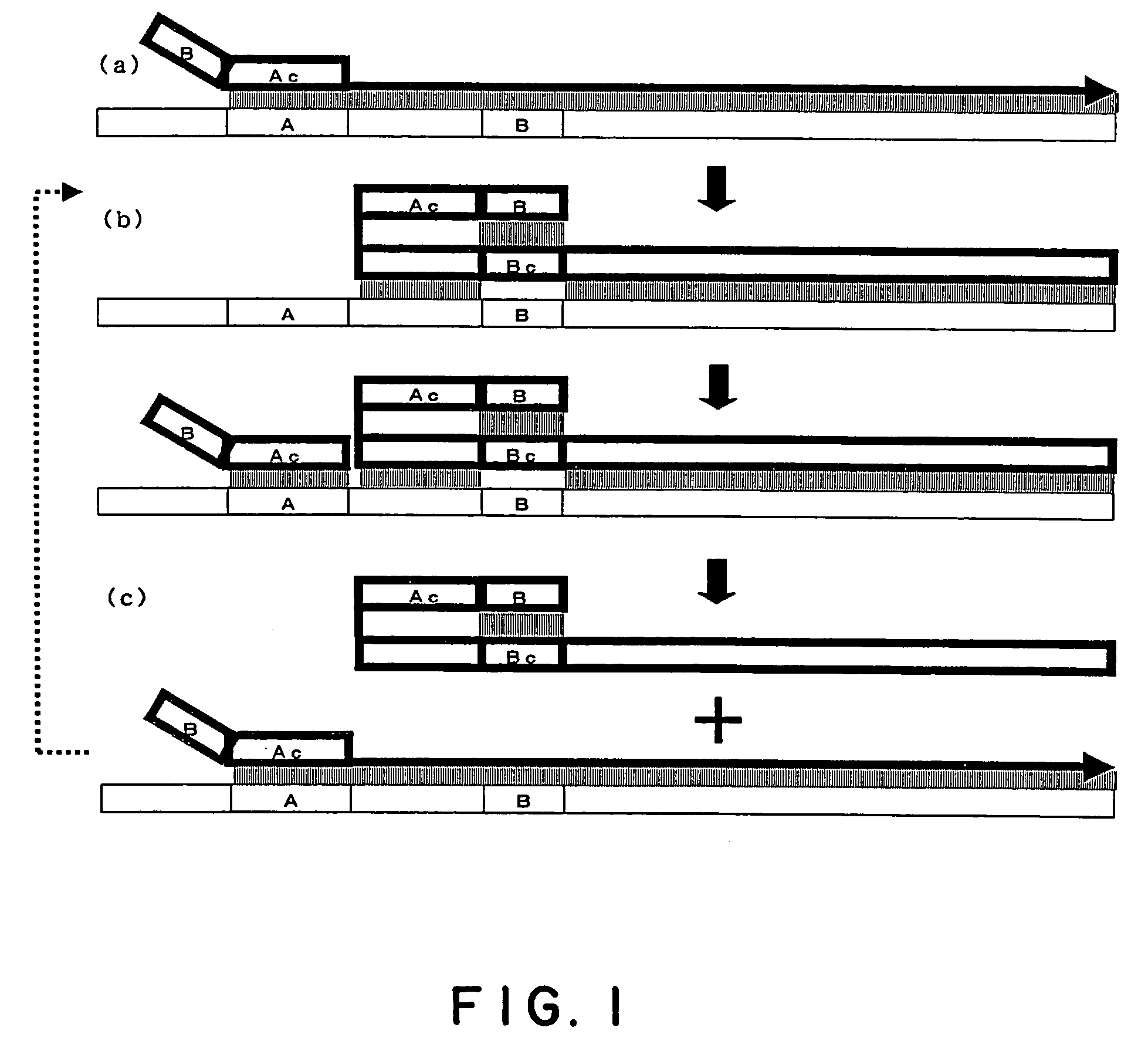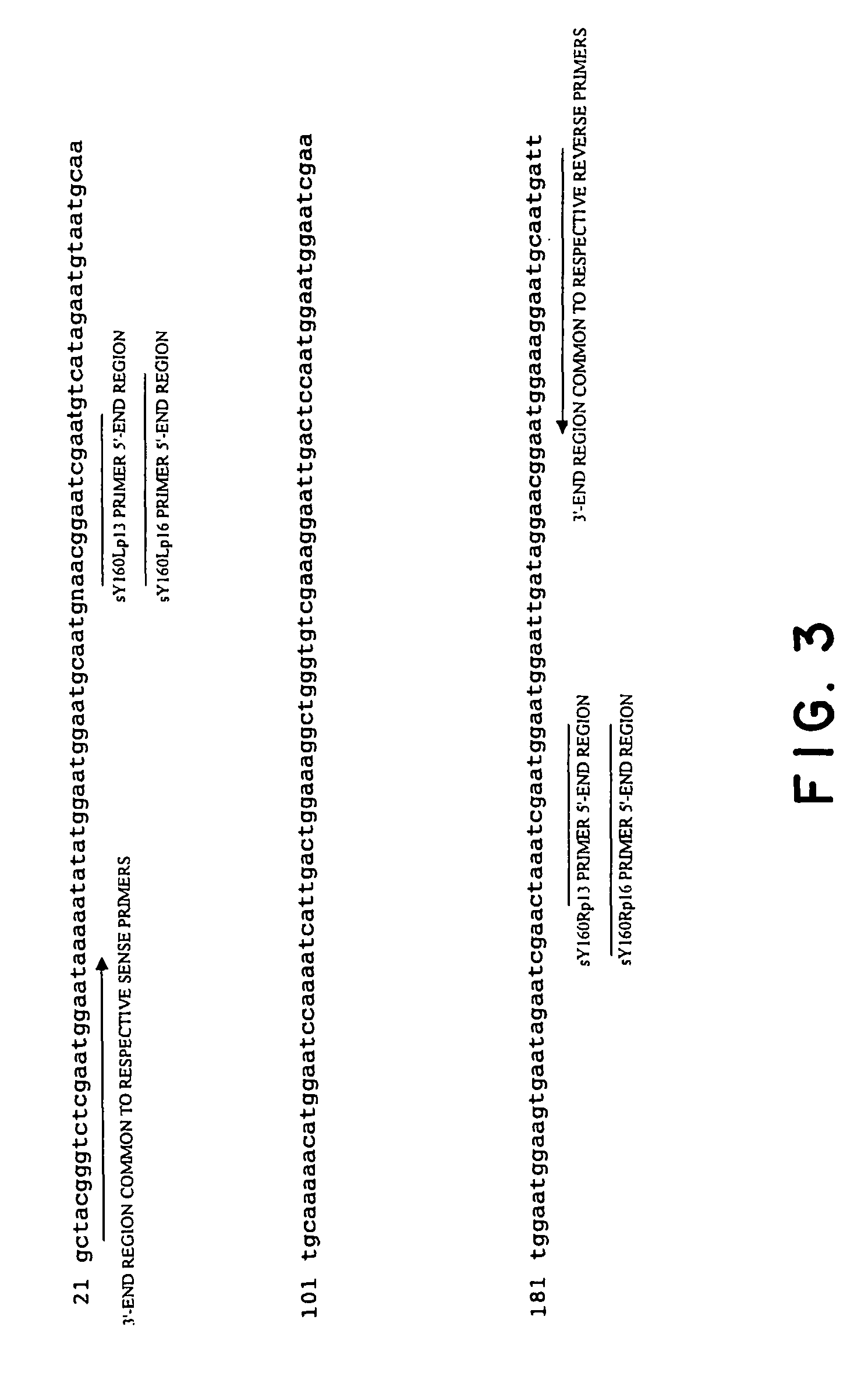Process for amplifying nucleic acid
a nucleic acid and amplifying technology, applied in the field of nucleic acid synthesizing process, can solve the problems of restriction enzyme breakage, high running cost of method, and longer time required
- Summary
- Abstract
- Description
- Claims
- Application Information
AI Technical Summary
Benefits of technology
Problems solved by technology
Method used
Image
Examples
example 1
[0123]In this example, the amplification of a human STS DYS237 gene was attempted with Human DNA (Clontech) as a template. Primers employed were as follows. These primers were synthesized by the consignment to ESPEC OLIGO SERVICE CORP.
[0124]The features of the primers used in the experiment were described below. The relationships of respective primers to the template were as illustrated in FIG. 2. In this connection, underlined parts in the following sequences represent 3′-end regions common to each of sense primers and antisense primers, respectively.
[0125]Primer set 1: a combination of primers comprising solely sequences annealing to the template (20 mer);
[0126]
SY153L: GCATCCTCATTTTATGTCCA; (SEQ ID NO: 1)SY153R: CAACCCAAAAGCACTGAGTA. (SEQ ID NO: 2)
[0127]Primer set 2: a combination of primers in which after annealing of sequences placed in the 3′-end side of the respective primers (20 mer: sequences identical to those in Primer set 1) to the template and extension reaction, a seque...
example 2
[0161]In this example, the amplification of an sY160 gene was attempted with Human DNA (Clontech) as a template. Primers employed were as follows. These primers were synthesized by the consignment to ESPEC OLIGO SERVICE CORP.
[0162]The features of the primers used in the experiment were described below. The relationships of respective primers to the template were as illustrated in FIG. 3. In this connection, underlined parts in the following sequences represent 3′-end regions common to each of sense primers and antisense primers, respectively.
[0163]Primer set 12: a combination of a sense primer in which after annealing of a sequenceplaced in the 3′-end side of a primer (20 mer) to the template and extension reaction, a sequence in the 5′-end side (13 mer) is hybridized with a region starting from 27 bases downstream of the 3′-end portion of the primer on a strand extended from the primer, and an antisense primer in which after annealing of a sequence placed in the 3′-end side of a pr...
example 3
[0172]In this example, the amplification of an M13mp18RF DNA (phage vector; TAKARA BIO INC.) was attempted with the same DNA as a template. Primers employed were as follows. These primers were synthesized by the consignment to ESPEC OLIGO SERVICE CORP.
[0173]The features of the primers used in the experiment were described below. The relationships of respective primers to the template were as illustrated in FIG. 4. In this connection, underlined parts in the following sequences represent 3′-end regions common to each of sense primers and antisense primers, respectively.
[0174]Primer set 14: a combination of a sense primer in which after annealing of a sequence placed in the 3′-end side of a primer (24 mer) to the template and extension reaction, a sequence in the 5′-end side (24 mer) is hybridized with a region starting from 51 bases downstream of the 3′-end portion of the primer on a strand extended from the primer, and an antisense primer in which after annealing of a sequence place...
PUM
| Property | Measurement | Unit |
|---|---|---|
| temperature | aaaaa | aaaaa |
| temperature | aaaaa | aaaaa |
| temperature | aaaaa | aaaaa |
Abstract
Description
Claims
Application Information
 Login to View More
Login to View More - R&D
- Intellectual Property
- Life Sciences
- Materials
- Tech Scout
- Unparalleled Data Quality
- Higher Quality Content
- 60% Fewer Hallucinations
Browse by: Latest US Patents, China's latest patents, Technical Efficacy Thesaurus, Application Domain, Technology Topic, Popular Technical Reports.
© 2025 PatSnap. All rights reserved.Legal|Privacy policy|Modern Slavery Act Transparency Statement|Sitemap|About US| Contact US: help@patsnap.com



